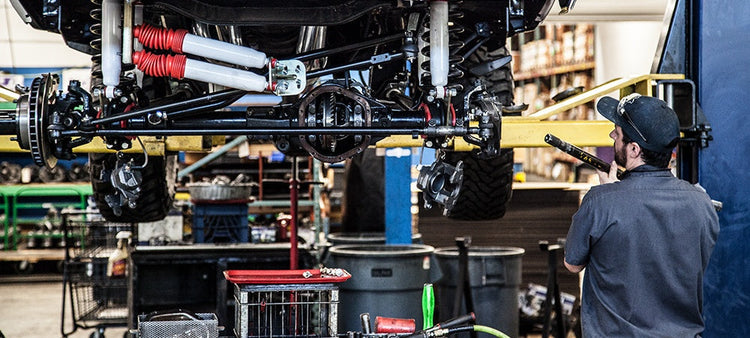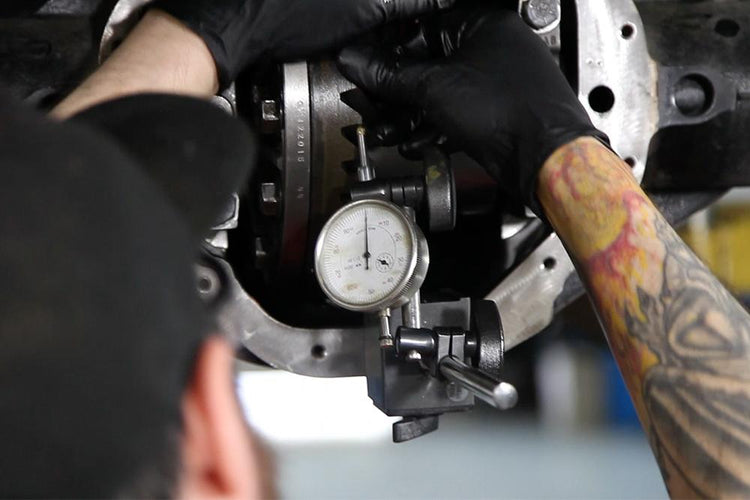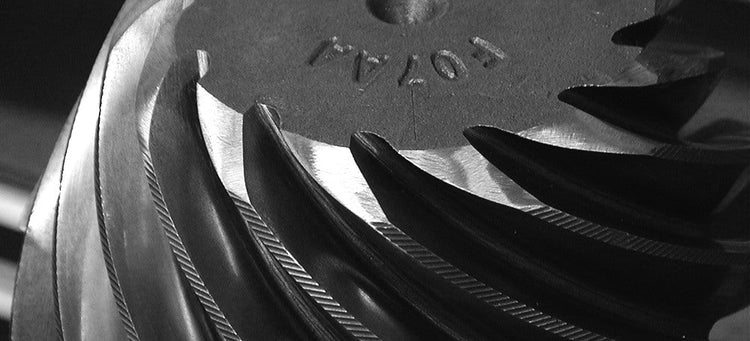
Differential Install: Small Details Make a Big Difference (Part 1)
Taking care of the details requires knowing which details are important, and having the discipline to check every detail on every job. Here is a partial list of details that we have found to make a difference when assembling a differential. Pay very close attention to the bearing hubs on the carrier case. If the old carrier bearing spins on the case, the new bearing will not fit tight and will also spin. Any wear due to a spinning carrier bearing will cause the backlash to open up and the ring & pinion gears will eventually break. Look carefully at the side gear bores and thrust washer surfaces to make certain they are not worn or galled. Make sure the cross pin shaft bores fit the cross pin tightly. Check the ring gear flange with a dial indicator to make sure there is minimal or no run-out. There are a lot of opinions as to how much carrier run-out is acceptable. We have seen as little as 0.005″ cause problems and we have seen differentials work fine with 0.009″ or more. The main thing that we look at is backlash variation. Keep the backlash variation under 0.005″ if possible. In a perfect world no variation would be the goal. However, even with a straight case the backlash can vary 0.005″ without any negative consequences, so this is an area where each assembler will have to decide how much they are willing to allow. Also look closely at the spider gears and cross pin shaft. The spider pinion gear and side gear teeth should be without pits or chips, and should not show any signs of heavy wear at the base of the contact patch. The spider pinion gears should not have any heavy wear or galling on the inside where they contact the cross shaft, and the cross pin shaft should show no more than light; even wear on the surface that contacts spider pinion gear without scratches or galling. The pinion yoke is another part that can cause a lot of problems if it is not in good shape. It is good idea to inspect the ears or shoulders that retain the universal joint. If there is any wear in these areas it is best to replace the yoke. Also inspect the seal surface closely. Small grooves or light rust can sometimes be polished away, but any irregular spots can cause the seal to leak if they do not polish out completely. Repair “redi sleeves” are available to press on the yoke and replace the seal surface of my popular models. These sleeves work fair in most cases but usually do not hold up as long as a new yoke The most often overlooked problem that we have found with yokes is the splines. On some models the splines seem to last forever, and on some they loosen up quickly. The splines should always fit tight and it should take a lot of pressure or pounding to drive the yoke down until it seats against the outer pinion bearing. One other area to inspect on the yoke is the surface that touches the outer pinion bearing or slinger. If this surface has light wear it can be filed down flat with a hand file as long as the surface is kept true and is not filed unevenly. Popular Resources: Limited Slips: Gov-Lock vs. Yukon Dura Grip Identifying Borg Warner Transfer Cases Limited Slips vs. Differential Lockers vs. Spools

Four Critical Ring & Pinion Settings
Although proper ring & pinion setup can be accomplished at home, I really recommend having a professional do the job. However, if a person really insists on trying it (and that is really the only way to learn), here is some information that should be helpful. When setting up a ring & pinion, there are four critical settings that need to be correct in order to get proper setup and good gear life. They are: Pinion depth (how close the pinion is to the ring gear), backlash (how close the ring gear is to the pinion), pinion bearing preload (how much bearing drag is on the pinion bearings), and carrier bearing preload (how much bearing drag is on the carrier bearings). Given enough time, just about any approach will work when setting up a ring & pinion. However, I suggest adjusting the four settings in the following order so that the job goes faster with less frustration. First, set the backlash using only light carrier bearing preload. The proper preload can be added closer to final assembly. Next, check the pinion depth by way of the contact pattern. Make sure you use only real gear marking compound (available from GM as part # 1052351), as other marking substances are difficult to read. There are many theories about how to read the contact pattern, but I won’t open that can of worms now. After checking the pattern, it is usually necessary to adjust the pinion depth. After changing the pinion depth, the pattern should be rechecked. The backlash may have to be readjusted as the pinion depth is changed. It should be close to specifications in order to get a good pattern reading. Once the correct pinion depth is established, the pinion bearing preload can be adjusted. When setting the pinion bearing preload on a crush sleeve design differential, it is always necessary to use a new crush sleeve every time the pinion nut is removed, or if the sleeve is over-crushed. When installing the carrier, the same adjusters or shims that are used to adjust the backlash are also used to set the carrier bearing preload. Rather than trying to change the backlash and preload at the same time, I recommend getting the backlash correct and then adding preload for the final assembly. If the carrier has to be moved to set the backlash, it is easier to remove if the preload is not too tight. Once the backlash has been set, the carrier bearing preload can be added. Some books give exact specifications of how much preload to add to the carrier bearings. I find that the given specs are not always easy to measure or achieve. If they call for 0.015″ preload, a zero point must first be established, and that is not easy either. I recommend setting the carrier bearing preload as tight as you can get it without damaging the shims during installation. For screw adjuster type differentials, I recommend about 100 to 150 ft lbs. of torque on the adjusters. From my experience, I have found it difficult to over preload the carrier bearings. I have only seen it done in a few cases, and those involved a mechanic with Schwarzenegger-like arms. Many people claim that setting the backlash too tight is good for high impact applications so that the backlash will not open up too wide. I have been guilty of this claim in the past; however, experience has shown me that it is lack of carrier bearing preload that causes the backlash to open up and not some magical transformation due to high shock loads. Now that these four settings are correct, the installation is almost complete. Remember to use good high quality oil and follow the manufacturer’s break-in procedure Popular Resources: New Gear Break-In Properly Setting Preload with Side Adjusters Size Matters

Fixing a chipped Pinion Gear
Some gear sets get chipped or nicked during the manufacturing process or during shipping. In most cases these blemishes are outside the contact pattern, and they can be removed with a few minutes of careful polishing. First thing is to determine if the nick is in the pattern. If this isn’t obvious by looking at the gear, you can install the set into the housing and run a quick pattern check. When you have determined that the chip or nick is clear of the pattern, use a medium grit 3M disk to polish out the nick. This is necessary to prevent any jagged edges from coming into contact with the gear under load and possibly causing damage. Popular Resources: Limited Slips: Gov-Lock vs. Yukon Dura Grip Identifying Borg Warner Transfer Cases Limited Slips vs. Differential Lockers vs. Spools


